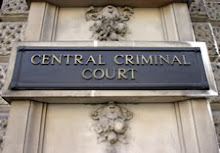From The Times
March 29, 2005
By Sean O’Neill
Children of the Old Bailey go from victims to knife-wielding offenders
HIGH on the walls of Old Bailey, the London street that lends its name to the world’s most famous court, is carved the austere mission statement of the Central Criminal Court.
It reads: “Defend the children of the poor and punish the wrongdoer.” Like the stonework, the sentiment expressed is tarnished. Increasingly, it seems, the children are the wrongdoers who come to the building for trial and punishment. This month alone, three schoolboy killers have been tried for murder. In each case, knives were used.
The third of these frighteningly similar trials ended in Court 15 with the conviction of Lasells Hazel, now 17, for the manslaughter of Kieran Rodney-Davis.
Kieran, 15, from Fulham, was stabbed in the chest after being confronted by a gang of masked teenagers, who stole his fashionable New Era baseball cap. Hazel, who burst into tears in the dock as the guilty verdict was returned, was not the youth who stabbed Kieran in the chest.
Continuing police inquiries led last week to the arrest of two youths in connection with the murder. They were subsequently released on bail.
A few days before Hazel’s conviction, in Court 10 Hakeem Johnson was sentenced to be detained at Her Majesty’s Pleasure for stabbing a pizza waiter in an argument over the price of a meal.
Johnson, of Highbury, North London, who was excluded from school, was just 13 when he stabbed Noor Kasimi, 32.
Three floors below, in Court 18, a jury found a 15-year-old boy guilty of the murder of Robert Levy, 16, in Hackney, East London. The youth, whose identity is protected by court order, pulled a knife after accusing another group of youths of “staring him out” on the street.
In March 1995, the cases that grabbed headlines in the court involved adults charged with rape and the trial of a man charged with starting a fire that killed 11 people in a pornographic cinema in Smithfield, Central London. A decade on, the court lists are dominated by knife-wielding teenagers whose readiness to use lethal violence is almost casual. These teenage defendants carry themselves with a swaggering defiance.
“The young age of the defendant is not the exception any more, it has almost become the rule,” Dave St George, who has been reporting trials at the Old Bailey for 35 years, said. “And it’s not just the Old Bailey. The other courts across London and the whole country are dealing with these crimes every day.”
Uanu Seshmi works with children who, he fears, have the potential to become Old Bailey defendants. They have been excluded from their schools, abandoned by their parents and found a sense of belonging by joining street gangs. In those hierarchies, respect is earned by carrying and using a knife.
“Young people are being fed a diet of gangster culture,” Mr Seshmi, director of the From Boyhood to Manhood Foundation, said. “It’s hip to be a gangster, hip to call women bitches and whores, hip to carry a knife, pull it out and stab someone. Carrying a knife is a statement, it’s making a stand — and stabbing a man is now an acceptable way of resolving conflict. This is a nationwide thing, an inner-city thing from London to Liverpool to Newcastle. There are many, many stabbings — wounds to the legs and arms — that are never reported to the police.”
Many of the teenagers he works with tell him that they carry knives for protection because they are frightened of being attacked. Others arm themselves because the knife has become a “street icon”.
Some are very aware that possession of a knife is an offence that carries a light sentence compared with carrying a gun. Nevertheless, guns, he said, were also becoming more common among teenagers.
Mr Seshmi’s recipe for tackling the knife culture is “tough love” — to challenge the youths and make them accept responsibility for their behaviour — but the programmes he runs are poorly resourced and some face closure.
He supports calls for tougher sentences for carrying knives and, controversially, a wider use of stop and search by the police. He said: “The situation is bad and getting worse, but if something is not done about these kids, to challenge their behaviour and give them an education, we are going to have a hell of a problem on our hands in five years’ time.”

No comments:
Post a Comment